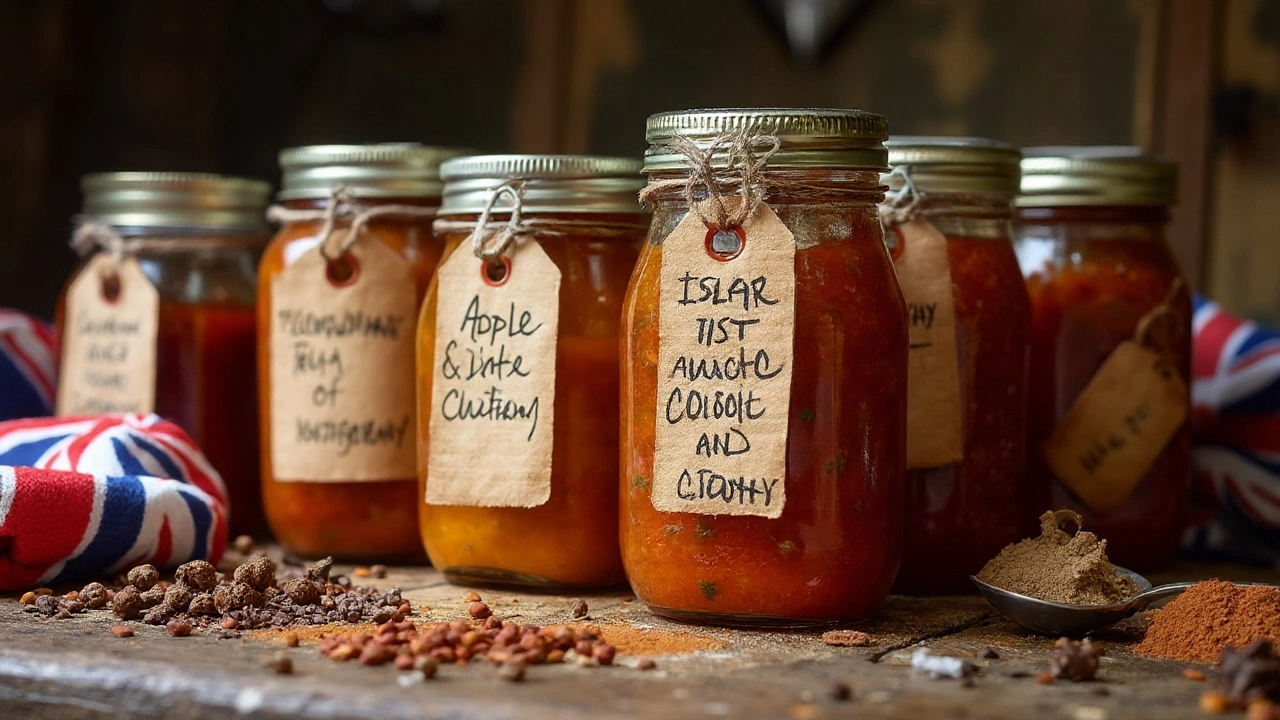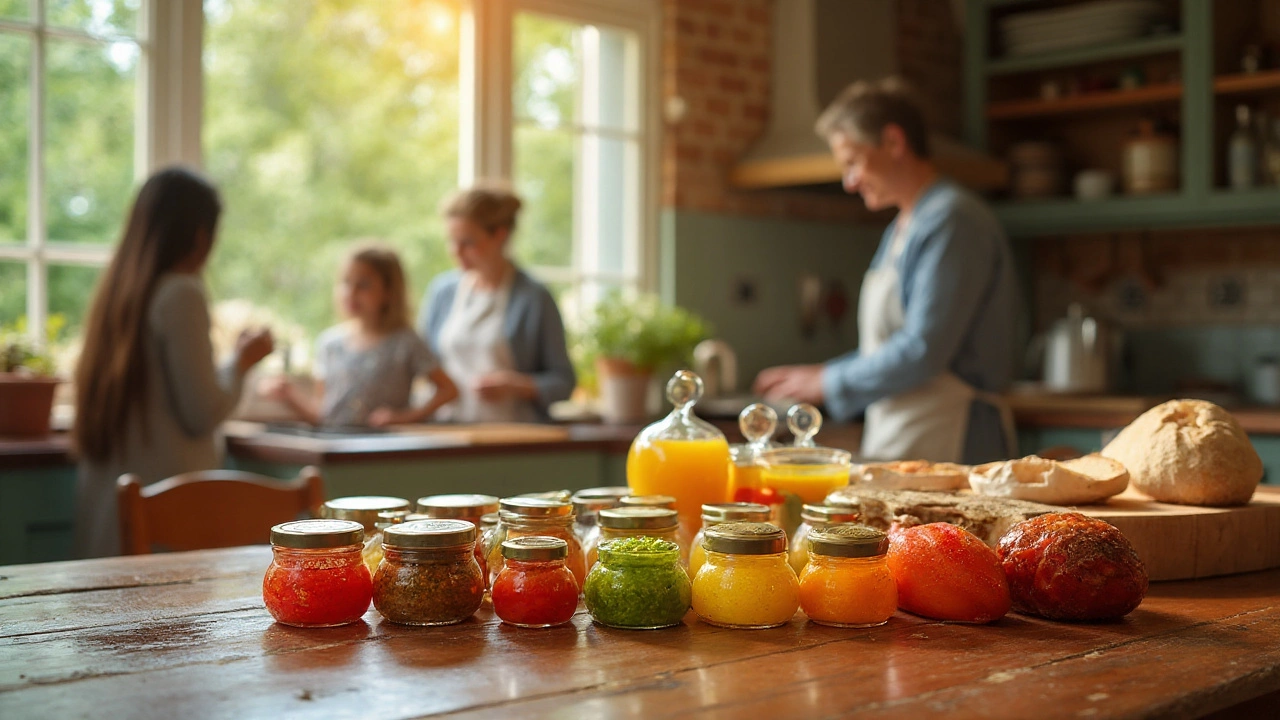If you’ve ever peered into a British cheese board or attended a classic British Sunday lunch, you’ve spotted that chunky, tangy stuff in jars—British chutney. It’s a staple in the UK, but here’s the wild part: British chutney is nothing like its Indian ancestor. The version we know today is sweet, savory, and packed with surprises, yet so many people in Britain aren’t even sure where it really comes from or how deeply it weaves itself into the country’s food traditions. But let’s be real, who can resist that balance of tart fruit, warm spice, sweet vinegar, and a touch of nostalgia? British chutney has its moments at summer picnics and holiday spreads, but most folks toss it on sandwiches or leftovers, too. So, what exactly makes British chutney special, and how did it even end up here? The story goes much further back than your grandma’s Christmas hamper.
Where Did British Chutney Come From?
Chutneys originally came from the Indian subcontinent, with the word “chutney” borrowed straight from the Hindi word “chatni,” meaning to lick, which fits because these relishes were all about big flavors made for noshing. In India, chutneys are usually fresh, spicy, and meant to be gobbled up right away. But with the British arrival in India during the colonial period, everything changed. British officers and their families got hooked on chutneys, but they faced one huge problem: traditional Indian chutneys didn’t last long, and ships heading back couldn’t keep them fresh. So, the British started experimenting with boiling the fruits and veggies, adding vinegar as a preservative, and sweetening with sugar—essentially creating what we now call ‘preserve-style chutney.’
By the 18th century, chutney recipes made their way to British cookbooks, but the big boom happened in the Victorian era. Cooks loved the sweet and tangy combo, and chutney was officially a thing. The most famous name is Major Grey’s Chutney, said to be invented by a British Army officer who missed the flavors of India. But that’s just the start. Chutney became a centerpiece of British food trends—especially in households that wanted to look adventurous but weren’t into fiery spice.
Now, if we’re talking stats, over 60% of British households buy chutney at least once a year, especially around Christmas. In British supermarkets, shelves groan under the weight of apple chutney, mango chutney, and other hybrids. Chutneys are made at home, too, as autumn hits and gardens are full of things to preserve. There’s even local chutney competitions popping up in community halls each fall. Chutney in Britain isn’t just a sauce; it’s a ritual, a memory of travels, and a kitchen tradition all rolled into one.
What Makes British Chutney Different?
The secret to British chutney is all about that magical balance between sweet, sour, and savory. Unlike the Indian originals—which are often fresh, spicy, and used almost like a salsa—British chutneys are slow-cooked, chunky relishes made to last for months in a jar. The most common base ingredients are apples, onions, tomatoes, or rhubarb, paired with raisins or sultanas, sugar, and malt vinegar. The vinegar’s tang is non-negotiable—skip it, and you don’t have proper chutney!
What makes these chutneys stand out is their texture. Forget the smoothness of ketchup or apple sauce; British chutney is chunky, rustic, and begs to be spooned, not poured. You can actually spot bits of fruit or veg in every jar. The spices tend to be mild—think ginger, mustard seed, sometimes a sneaky hit of chili, but definitely not the face-melting heat of Indian relishes. That’s probably why it appeals to so many: complex flavors, but nothing threatening.
Here’s a fun fact—it’s not just about preserving, it’s about stretching flavors across the bleak British winter. Chutney started as a “waste not” idea, using up whatever you had too much of from the garden before the cold came crashing in. Even today, some British families still hold onto their own secret recipes, passed down for generations. You’ll find handwritten labels on jars at local fairs, each one bragging about its “prize-winning” status or what year it’s from—because some swear chutney gets better with age.

The Variety of Flavors You’ll Find
If you think all British chutneys are just a blend of apples, onions, and raisins, think again. While that’s the classic combination—often found shoved into cheese sandwiches or globbed onto roast meats—there’s a chutney for pretty much any taste. Mango chutney is probably the star in Britain’s Indian restaurants, paired with poppadoms, but apple, ploughman’s, date, or even green tomato chutney are all homegrown favorites.
Let’s break it down a bit more:
- Apple Chutney: Tart apples with onions, brown sugar, and warm spices like cinnamon or clove. A favorite with sharp cheddar or pork pies.
- Mango Chutney: Sweeter, with a touch of spice, and a lot more common in Indian takeaways than in Sunday roasts.
- Tomato Chutney: More savory, made with fresh or green tomatoes, sometimes seasoned with chili for a gentle kick.
- Rhubarb or Plum Chutney: A short-season treat, tangy and rich, goes great with cold meats or sausages.
- Date & Fig Chutney: Dense, sticky, and often seen during the holidays for pairing with strong blue cheese or cold turkey.
That variety explains why British chutney fits any meal. It transforms a humble cheese sandwich into a tasty bite, perks up leftovers, or adds a zingy layer to hot, buttery toast (try it before you judge!). Chutneys also go wild at British food festivals—think wild garlic chutney, red onion and ale chutney, and hot chili-ginger blends hitting the market stalls. There’s something quirky and practical about chutney—if you can grow it or forage it, someone in Britain is probably already turning it into a preserve as we speak.
| Chutney Name | Main Ingredients | Best For | Flavor Profile |
|---|---|---|---|
| Apple Chutney | Apples, Onions, Vinegar, Sugar | Cheddar cheese, Pork | Sweet and tangy |
| Mango Chutney | Mango, Sugar, Vinegar, Ginger | Poppadoms, Curries | Sweet, mild spice |
| Tomato Chutney | Tomatoes, Sugar, Vinegar, Onion | Sausages, Cold meats | Savory, slight heat |
| Date & Fig Chutney | Dates, Figs, Brown sugar, Vinegar | Blue cheese, Game | Rich, sticky, sweet |
| Ploughman’s Chutney | Mixed fruit, Vinegar, Spices | Ploughman’s lunch | Complex, aromatic |
How British Chutney Is Made
Got fruit or veg that’s past its prime? British chutney started as a rescue dish—you’re giving old apples, squashy tomatoes, and end-of-season garden bounty a glamorous second life. The basic process goes like this: chop up your produce, toss everything in a big pot with vinegar, sugar, raisins (or sultanas), and your favorite spices, then let it simmer. A real chutney needs patience. You’re not just making a jam or quick sauce. The slow bubbling breaks down fruit and veggies, thickens the syrup, and blends all those flavors into that unmistakable chutney goodness.
Malt vinegar is the usual pick in the UK, which gives chutney its bold punch. Spices are usually mild but depend on household taste—ginger, mustard seed, coriander seed, black pepper, or sometimes a dash of chili for warmth. The longer you let everything simmer, the thicker and more mellow it gets. It should cling to your knife, not run through your fingers.
When it comes to bottling, chutney lovers swear by sterilized glass jars, but you’ve got to be patient—the flavors really wake up after a month or two in a cool cupboard. Some say a jar of chutney that’s aged a year is the best you’ll ever taste. Here’s a secret tip: try adding a chopped dried fig or two for a rich, sticky finish or a glug of local cider for a Somerset twist.
If you make chutney at home, don’t panic if it tastes sharp or vinegary at first—it softens with time. Just keep those jars sealed and store them in a cool spot. Your efforts will pay off, especially around holiday season or for a summer picnic. Yes, you’ll probably become the friend who’s always asked to “bring the chutney.”

Serving and Enjoying British Chutney
So you’ve got a jar (or a dozen) of homemade or shop-bought chutney—now what? Don’t limit yourself to cheese and cold cuts, as tasty as that combo is. British chutney works on almost anything: spoon a dollop into curries for extra tang, swirl it through mayo for a sandwich spread, toss it with roasted veggies, or layer it inside toasties for quick lunches that taste like effort. Some British families swear by a blob of chutney on bubble and squeak (that fried potato-cabbage breakfast), or even with simple poached eggs.
If you want to go full Brit, serve your chutney with a Ploughman’s lunch—crusty bread, strong cheese, pickled onions, and whatever salady bits are knocking about. Chutney glues all those flavors together into something you actually crave. It’s perfect for cutting through rich meats or livening up winter leftovers. Got roast beef or ham to use up? Slather on chutney for a sweet-sour punch.
Chutneys also work their way into modern British cooking—think sticky-glazed chutney chicken wings, chutney-baked camembert, or rustic sausage rolls brushed with tomato chutney for shine. Even in vegan and veggie cooking, chutney stars as a secret weapon, adding depth and a touch of excitement to grains, pulses, or plant-based burgers.
Never underestimate British chutney at a picnic, either. It transforms bland supermarket sausage rolls into a treat and doubles as a dip with cold veggies. If you’re hosting friends, try mixing chutney into some crème fraîche or Greek yogurt for a quick dip—they’ll love the twist. And if you just end up eating it by the spoonful? Well, no judgment from anyone who’s ever made chutney from scratch.
